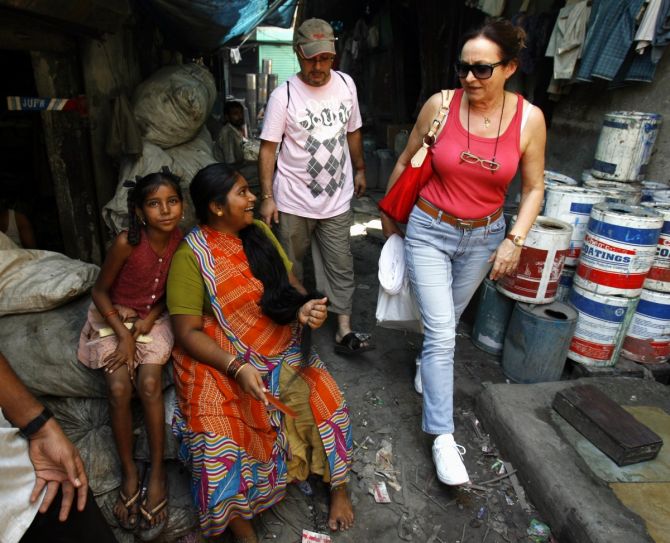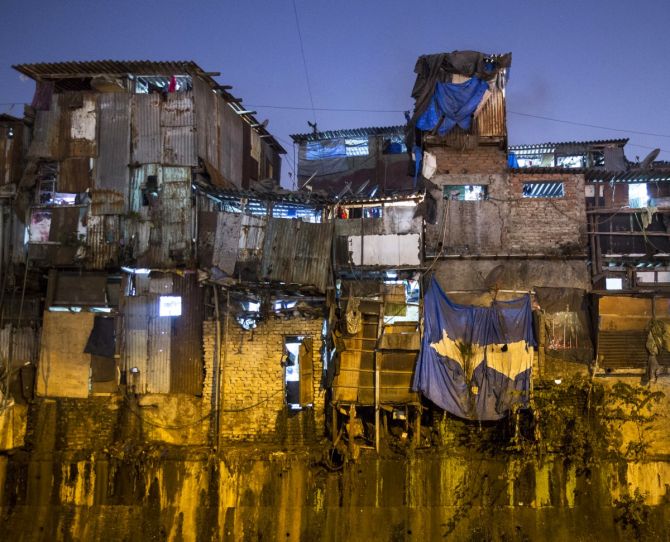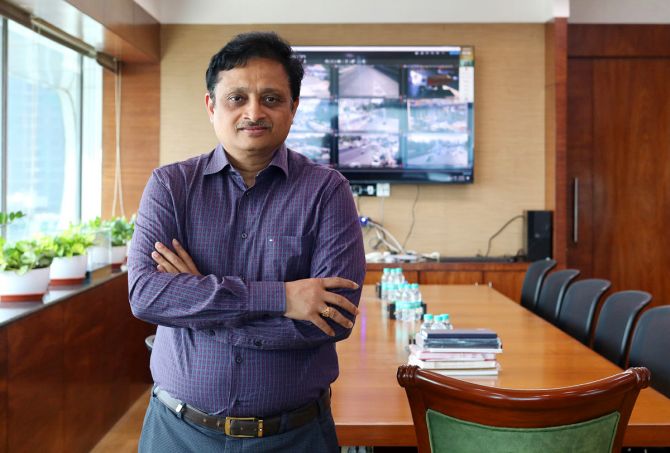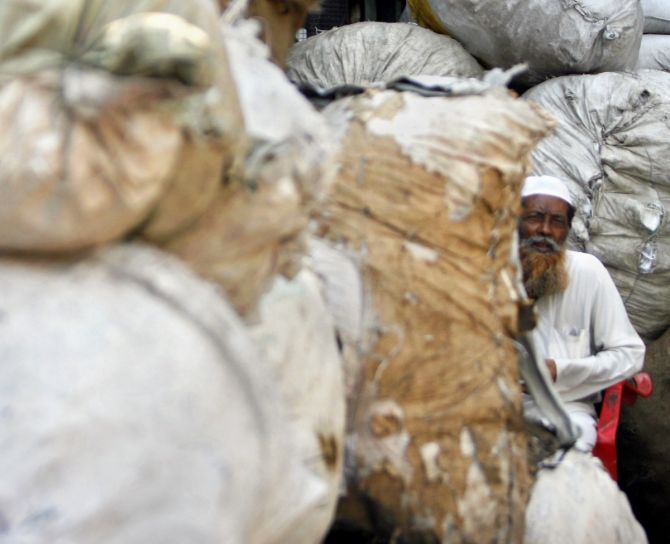'Dharavi will be completely slum free by 2040.'

If you travel on Mumbai's metro line 2A or line 7, then you must feel a sense of relief over not getting stuck in a traffic jam.
You need to thank Maharashtra Additional Chief Secretary and Metropolitan Commissioner, Mumbai Metropolitan Region Development Authority (MMRDA), S V R Srinivas, who executed these two projects for which he has been receiving congratulatory messages from every quarter.
Srinivas has NOW got a huge challenge ahead -- the redevelopment of India's largest slum area, Dharavi, located in north central Mumbai.
Appointed chief executive officer, Dharavi Redevelopment Project, by the Maharashtra government, he has been given a deadline of seven years to ensure that slum-dwellers move into their new homes.
It is a huge challenge and Srinivas knows it because in his own words, "Dharavi is a city within a city."
Spread across 240 acres and home to about 700,000 people, Dharavi finds mentions in the same breath as the other world's largest slums that include Khayelitsha in Cape Town, South Africa; Kibera in Nairobi, Kenya; Neza in Mexico; Orangi Town in Karachi.
Srinivas's job is to ensure that Dharavi's name is taken off the above list.
The redevelopment of Dharavi has come after the Adani group was declared the winner for the Dharavi Redevelopment Project.
The Adani group won the bid in November 2022 by promising an initial investment of Rs 5,069 crore (Rs 50.69 billion) for the over Rs 20,000 crore (Rs 200 billion) project.
Dharavi became world famous as it was one of the locations where the Oscar-winning film Slumdog Millionaire was shot.
Syed Firdaus Ashraf/Rediff.com spoke to Srinivas on how he plans to change the face of Dharavi and what the life of Dharavi residents will be like after the redevelopment.
The first of a two-part Must-Read Interview.

One of my colleagues who stays in Dharavi was so excited to know that I was coming to meet you. He wanted me to ask you just one question: Will the quality of life improve after this project is complete?
Yes, of course, the quality of life will improve for the residents of Dharavi. The lives of people of Mumbai will also improve.
In what way?
One of the fundamental things about life is predictability in which the first thing is that you are going to live in the same place where you have been living. And whether my business will continue at the same place. This thing was not there for the slum-dwellers of Dharavi.
Although there is a Slum aAt which gives them protection, but in actual practice they do feel a certain uncertainty, which redevelopment will do away with.
Philosopher Thomas Hobbes famously said, 'The life of man is solitary, poor, nasty, brutish and short' in the book Leviathan. I am just giving a figurative comparison.
Quality of life will improve in Dharavi.
Every house in the redeveloped Dharavi will have drinking water available and a toilet inside homes.
Every day nobody wants to stand in a queue to answer nature's call. And if you can do that at your own home rather than AT a public toilet, then surely your quality of life is going to improve.

But many in Dharavi are not willing to believe this project will take off because of the Dharavi redevelopment story they have been hearing from Rajiv Gandhi's days. Nothing came of it in the last 40 years.
I can understand their scepticism because this has been the longest redevelopment bid.
The Dharavi redevelopment bid began in 2004 and it was after 18 years in 2022 the bid was accepted and the work is going to start now.
This was a longer period than Lord Rama's exiled years or even that of the Pandavas.
I am confident now it will be a successful project with the support of local residents of Dharavi who are the biggest stakeholders.
How do you convince 58,000 homes and 13,000 businesses to move out to a new place?
The biggest issue in Dharavi which is the brownest of brownfield projects (a tract of land that has been developed for industrial purposes, polluted, and then abandoned) in the world.
It is the largest urban renewable project in the world.
This makes the project extremely complex. And the question that everyone is asking us is, who is going to be rehabilitated? And here the biggest question is, who is eligible and who is not eligible?
At present according to the Slum Act you are eligible to get a place only if you were present before January 1, 2000.
If you have come after 2011 then you will have to make a certain payment.
Therefore, there is a huge ineligibility factor involved. Also, we are giving new houses according to only the ground floor structure of the slums.
Mezzanine floor structure will not be considered as a part of their house.
All the Slum Redevelopment Authority Projects in Mumbai city throw away the mezzanine floor people of slums when they redevelop the area.

Will you do the same?
No, because the numbers are large. The housing minister, Devendra Fadnavis, who is also deputy chief minister of Maharashtra, said the eligibility for this project has to be all inclusive.
The formula that we are deriving is that those who are eligible will get free housing. And those who are not, like those who came after January 1, 2011 and the ones who live on mezzanine floors, will be given a rental housing scheme within a radius of 10 km of the project.
We are doing so because there will be a moral hazard if we treat a person with eligible and non-eligible terms differently for this project.
We are going to give them a rental housing scheme with a caveat that they can even purchase that house.
Eventually, they will also become owners and this is what differentiates the Dharavi redevelopment project from any of the other slum redevelopment projects.
This is an all inclusive project and out of the box treatment.
In 2016, there was a bid, but nobody came to redevelop Dharavi because of these issues.
What is the time frame for these homeowners to move into their new homes?
We have given 7 years from the commencement certificate time.
It is not easy to achieve and it is a challenging task but we are confident that we will be able to deliver.

What about the environmental impact of the project due to concretisation of Dharavi? The Mithi river passes through Dharavi which was the cause for flooding in the infamous Mumbai floods of July 26, 2005.
Environmental disaster is already happening in Dharavi.
If you see, sewage and all the dirt is already going into the Mithi river for almost a century now.
There is no sanitation in Dharavi. Moreover, there is a leather and textile industry which is in the informal sector and throws its waste at the same place.
There is no environment management plan in place for Dharavi.
All these things will come in place, but there will be a cost to this.
There was no environmental management plan. And once you formalise the economy, the lower economic strata of the society will have to comply with certain norms for which we have given certain concessions to local industries.
This will be a very positive step regarding the environment. Secondly, Mahim Nature Park located in Dharavi will not be touched.
We have clarified that to the courts. We want Dharavi to be a platinum city. It will be like a township and that is what our target is.
Does it mean Dharavi will be completely slum free by 2040?
It should be and it will be. I will not say dot dot because it is a collaborative effort.
So far, things are going smoothly and we had successful meetings.

Do you fear that residents of Dharavi might not want to move out and resist the state's move to replace them?
Not really. I feel most of them will be happy to move into their new houses.
In economics there is something called the impossibility theorem (the thesis that it is generally impossible to assess the common good) for which people have won Nobel Prizes too.
A majority of Dharavi residents will support us because they want certainty in life and the fact that we are giving them good dispensation.
50 people use one toilet in Dharavi so how will you make a temporary arrangement while shifting them? Where will you build these toilets?
That is the reason I don't sit in my office room and I am in Dharavi. It is a very difficult task.
The general norm is that when redevelopment takes place transit takes place where people are shifted in a redevelopment project. And after two years or so they are shifted to new buildings.
In Dharavi we are trying to do away with the intermediate system.
Instead of transit we want to take them directly to their new homes from their old homes.
This is because their livelihoods will not be disturbed as well as the businesses they do will not be affected.
Is there a pocket where land is empty and you can construct new homes for these people?
Yes, there is.
Is that railway land?
Yes, that is railway land. Railway land was very crucial for this project. And that is the reason the honourable Prime Minister of India Shri Narendra Modiji stepped in.
Honourable Deputy Chief Minister of Maharashtra, Devendra Fadnavis, took the initiative for this to get the issue resolved.
What about schools? Will children not be displaced to a further distance?
I will talk about a larger aspect. One is construction of homes and second is construction of factories and shops.
The other aspects are schools, hospitals, community centres and recreational centres. We have to build all these things.
In Dharavi, we are building a city within a city. It is bigger than many municipal corporations of India in terms of demography. It represents ethnically mini India.
We will definitely ensure schools, hospitals and community centres are built. And another aspect is electrification, building of roads, sewage and storm water.
We have to increase the carrying capacity of this 2.2 sq km of land as right now there is no carrying capacity of this land right now and it has collapsed.
In Hong Kong the project Tai Hang was re-built by demolishing slums. Are you following their footsteps?
Tai Hang developed, but it was a much smaller project than Dharavi. Hong Kong was different and things were much easier.
You see the density of the population of Dharavi.
You see the number of commercial structures and we have to take care of livelihoods.
The issue of eligibility too is there (on who should get new homes). You name it and that complexity is there in Dharavi.
It is a complex problem.
We want to develop Dharavi like Hong Kong.
Feature Presentation: Rajesh Alva/Rediff.com










